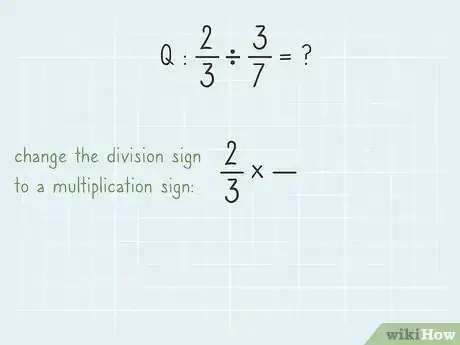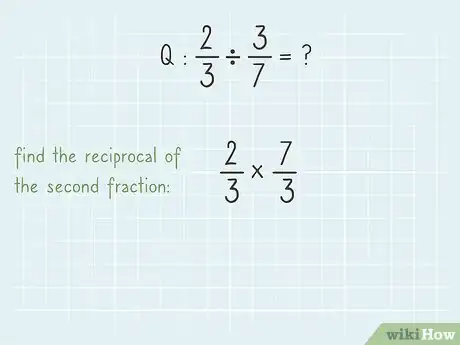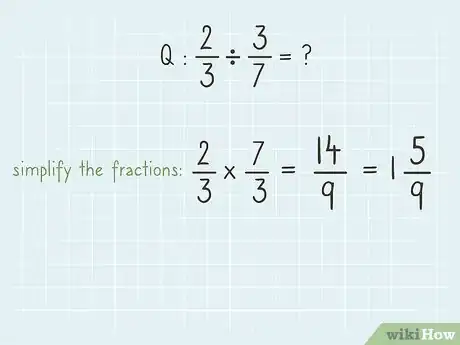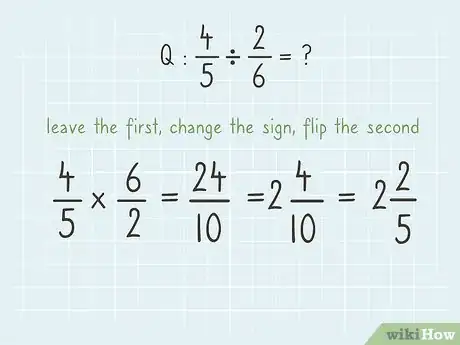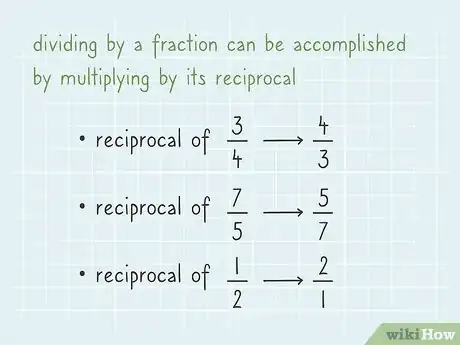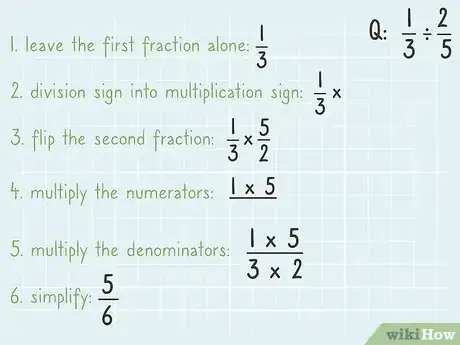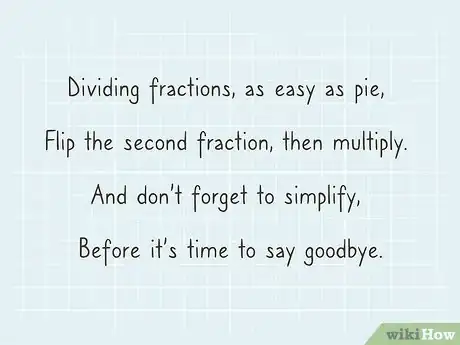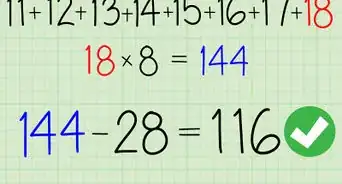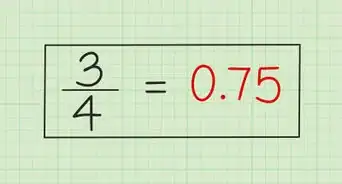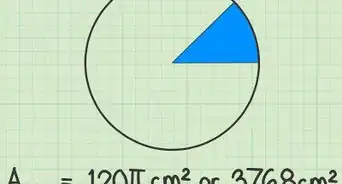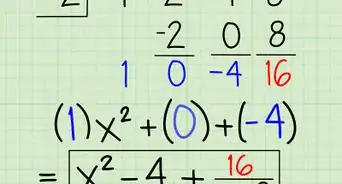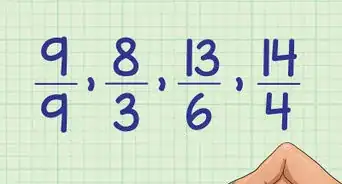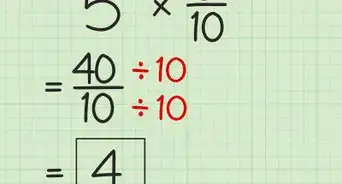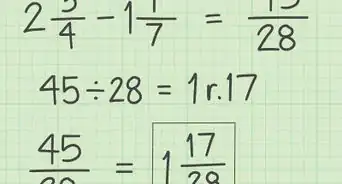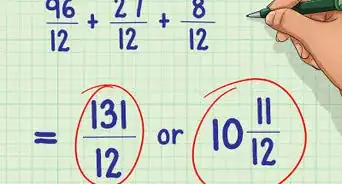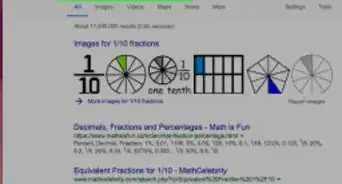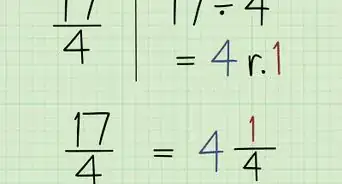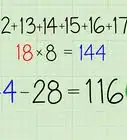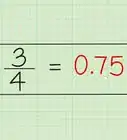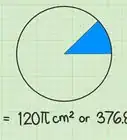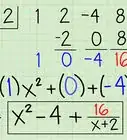This article was co-authored by Grace Imson, MA. Grace Imson is a math teacher with over 40 years of teaching experience. Grace is currently a math instructor at the City College of San Francisco and was previously in the Math Department at Saint Louis University. She has taught math at the elementary, middle, high school, and college levels. She has an MA in Education, specializing in Administration and Supervision from Saint Louis University.
There are 9 references cited in this article, which can be found at the bottom of the page.
wikiHow marks an article as reader-approved once it receives enough positive feedback. This article received 34 testimonials and 84% of readers who voted found it helpful, earning it our reader-approved status.
This article has been viewed 1,827,436 times.
Dividing a fraction by a fraction might seem confusing at first, but it is really very simple. All you need to do is flip the second fractions, multiply, and reduce![1] This article will guide you through the process and show you that dividing fractions by fractions is really a breeze.
Steps
Dividing Fractions by Fractions (Example)
-
1Begin with an example problem. Let's use 2/3 ÷ 3/7. This question is asking us how many parts equal to 3/7 of a whole can be found in the value 2/3. Don't worry; it's not as hard as it sounds!
-
2Change the division sign to a multiplication sign. Your new equation should read: 2/3 * __ (we'll fill in the blank in a moment.)[2]Advertisement
-
3
-
4Multiply your fractions.[6] First multiply the numerators of the two fractions together: 2 * 7 = 14. 14 is the numerator (top value) of your answer. Then multiply the denominators of the two fractions together: 3 * 3 = 9. 9 is the denominator (bottom value) of your answer.[7] You now know that 2/3 * 7/3 = 14/9.
-
5Simplify your fraction. In this case, because the numerator of the fraction is larger than the denominator, we know that our fraction is larger than 1, and we should convert it to a mixed fraction. (A mixed fraction is a whole number and a fraction combined, like 1 2/3).[8]
- First divide the numerator 14 by 9. 9 goes into 14 one time, with a remainder of 5, so you should write out your reduced fraction out as: 1 5/9 (“one and five ninths”).
- Stop there, you have found your answer! You can determine that you cannot reduce the fraction further because the denominator is not evenly divisible by the numerator (9 cannot be divided evenly by 5) and the numerator is a prime number, or an integer that can only be divisible by one and itself.[9]
-
6Try another example! Let's try the problem 4/5 ÷ 2/6 =. First change the division sign to a multiplication sign (4/5 * __ = ), then find the reciprocal of 2/6, which is 6/2. You know have the equation: 4/5 * 6/2 =__. Now multiply the numerators, 4 * 6 = 24, and the denominators 5* 2 = 10. You now have4/5 * 6/2 = 24/10.[10] Now simplify the fraction. Because the numerator is larger than the denominator, we will need to convert this to a mixed fraction.
- First divide the numerator by the denominator, (24/10 = 2 remainder 4).
- Write the answer out as 2 4/10. We could still reduce this fraction further!
- Note that 4 and 10 are both even numbers, so the first step in reducing them is to divide them each by 2. We end up with 2/5.
- Because the denominator (5) cannot be divided evenly by the numerator (2), and it is a prime number, we know that it cannot be reduced further. Our answer is thus: 2 2/5.
-
7Get additional help with reducing fractions. You probably spent a lot of time learning to reduce fractions before trying to divide them by each other, but if you need a refresher or some more help, there are some great articles online that can help you a lot. [11]
Understanding How to Divide Fractions by Fractions
-
1Think about what dividing by a fraction means. The problem 2 ÷ 1/2 is asking you: ”How many halves are in 2?” The answer is 4, because each unit (1) is made up of two halves, and there are 2 units total: 2 halves/1 unit * 2 units = 4 halves.
- Try thinking about this same equation in terms of cups of water: How many half cups of water are in 2 cups of water? You could pour 2 half cups of water into each cup of water which means you are basically adding them, and you have two cups: 2 halves/1 cup * 2 cups = 4 halves.
- All of this means that when the fraction you are dividing by is between 0 and 1, the answer will always be larger than the original number! This is true whether you are dividing whole numbers or fractions by a fraction.
-
2Understand that dividing is the opposite of multiplying. Therefore, dividing by a fraction can be accomplished by multiplying by its reciprocal.[12] [13] The reciprocal of a fraction (also called its “multiplicative inverse”) is just the fraction turned upside down, so that the numerator and denominator have switched places.[14] In a moment, we are going to divide fractions by fractions by finding the reciprocal of the second fraction and multiplying them together, but let's look at some reciprocals first:
- The reciprocal of 3/4 is 4/3.
- The reciprocal of 7/5 is 5/7.
- The reciprocal of 1/2 is 2/1, or 2.
-
3Memorize the following steps for dividing a fraction by a fraction. In order, the steps are:[15]
- Leave the first fraction in the equation alone.
- Turn the division sign into a multiplication sign.
- Flip the second fraction over (find its reciprocal).[16]
- Multiply the numerators (top numbers) of the two fractions together. This result will be the numerator (top portion) of your answer. [17] [18]
- Multiply the denominators (bottom numbers) of the two fractions together. The result will be the denominator of your answer.[19]
- Simplify your fraction by reducing it to the simplest terms.
-
4Work through these steps on the example 1/3 ÷ 2/5. We will begin by leaving the first fraction alone, and changing the division sign to a multiplication sign:
- 1/3 ÷ 2/5 = becomes:
- 1/3 * __ =
- Now we flip the second fraction (2/5) over to find its reciprocal, 5/2:[20]
- 1/3 * 5/2 =
- Now multiply the numerators (top numbers) of the two fractions, 1*5 = 5.[21]
- 1/3 * 5/2 = 5/
- Now multiply the denominators (bottom numbers) of the two fractions, 3*2 = 6.[22]
- We now have: 1/3 * 5/2 = 5/6
- This particular fraction cannot be simplified further, so we have our answer.
-
5Try remembering the following rhyme to help you remember: "Dividing fractions, as easy as pie, Flip the second fraction, then multiply. And don't forget to simplify, Before it's time to say goodbye." [23]
- Another helpful saying that tells you what to do with each part of the equation is: “Leave Me (the first fraction), Change Me (the division symbol), Turn Me Over (the second fraction).”
Community Q&A
-
QuestionWhat is 2 1/2 divided by 1/2?
 DonaganTop AnswererChange the mixed number to an improper fraction: 2½ becomes 5/2. Then invert ½ to become 2/1. Multiply 5/2 by 2/1, and reduce or simplify if possible. (5/2)(2/1) = 10/2 = 5.
DonaganTop AnswererChange the mixed number to an improper fraction: 2½ becomes 5/2. Then invert ½ to become 2/1. Multiply 5/2 by 2/1, and reduce or simplify if possible. (5/2)(2/1) = 10/2 = 5. -
QuestionHow do I divide 3/4 by 3/5?
 DonaganTop AnswererInvert 3/5 to 5/3, and multiply by ¾: (3/4) x (5/3) = 15/12 = 5/4 or 1¼.
DonaganTop AnswererInvert 3/5 to 5/3, and multiply by ¾: (3/4) x (5/3) = 15/12 = 5/4 or 1¼. -
QuestionHow do I find the reciprocal of a whole number?
 DonaganTop AnswererThe reciprocal is a fraction whose numerator is 1 and whose denominator is the whole number. For example, if the whole number is 5, think of it as 5/1, then invert that fraction to 1/5.
DonaganTop AnswererThe reciprocal is a fraction whose numerator is 1 and whose denominator is the whole number. For example, if the whole number is 5, think of it as 5/1, then invert that fraction to 1/5.
References
- ↑ David Jia. Academic Tutor. Expert Interview. 7 January 2021.
- ↑ https://www.mathsisfun.com/fractions_division.html
- ↑ Grace Imson, MA. Math Teacher. Expert Interview. 1 November 2019.
- ↑ David Jia. Academic Tutor. Expert Interview. 7 January 2021.
- ↑ https://www.mathsisfun.com/fractions_division.html
- ↑ Grace Imson, MA. Math Teacher. Expert Interview. 1 November 2019.
- ↑ David Jia. Academic Tutor. Expert Interview. 7 January 2021.
- ↑ http://www.mathsisfun.com/mixed-fractions.html(
- ↑ http://primes.utm.edu/glossary/xpage/prime.html
- ↑ David Jia. Academic Tutor. Expert Interview. 7 January 2021.
- ↑ https://www.mathsisfun.com/simplifying-fractions.html
- ↑ Grace Imson, MA. Math Teacher. Expert Interview. 1 November 2019.
- ↑ David Jia. Academic Tutor. Expert Interview. 7 January 2021.
- ↑ https://www.cuemath.com/numbers/division-of-fractions/
- ↑ https://www.cuemath.com/numbers/division-of-fractions/
- ↑ David Jia. Academic Tutor. Expert Interview. 7 January 2021.
- ↑ https://www.mathsisfun.com/definitions/numerator.html
- ↑ David Jia. Academic Tutor. Expert Interview. 7 January 2021.
- ↑ David Jia. Academic Tutor. Expert Interview. 7 January 2021.
- ↑ David Jia. Academic Tutor. Expert Interview. 7 January 2021.
- ↑ David Jia. Academic Tutor. Expert Interview. 7 January 2021.
- ↑ David Jia. Academic Tutor. Expert Interview. 7 January 2021.
- ↑ http://www.mathsisfun.com/fractions_division.html
About This Article
To divide fractions by fractions, start by replacing the division sign with a multiplication sign. Then, flip the second fraction over so the bottom number of the second fraction is now on the top. Multiply the top numbers of both fractions together to get the numerator (top number) of your new fraction. To get the denominator (bottom number) of your new fraction, multiply the bottom numbers of both fractions together. Simplify your fraction and you're finished! For actual examples of fractions being divided, read the article!


